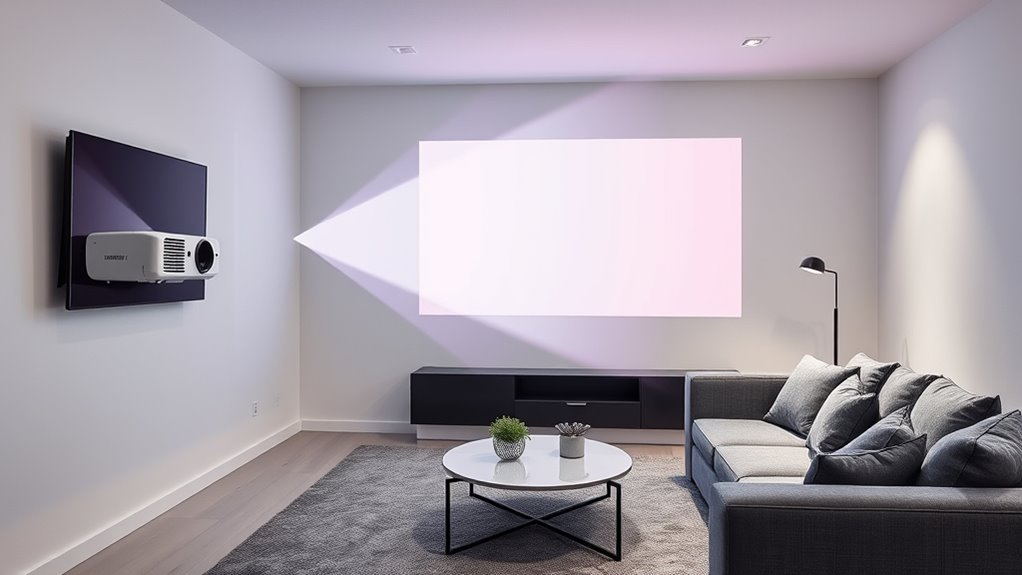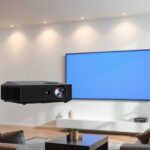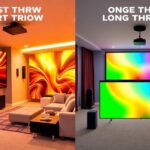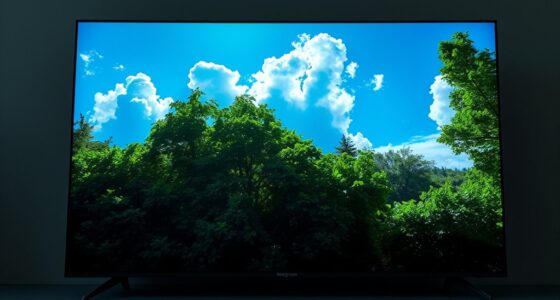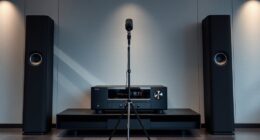Short-throw and ultra-short-throw projectors are designed to produce large images from very close to the screen or wall, making them perfect for small spaces like classrooms, offices, or home theaters. They require less distance for projection, saving room and reducing shadows during presentations. While they need careful setup for peak image quality, their space-efficient design offers impressive visuals in tight areas. Keep exploring to learn more about how these projectors can fit your needs.
Key Takeaways
- Short-throw projectors can project large images from a short distance, typically between 3 to 8 feet from the screen.
- Ultra-short-throw projectors are designed to display large images from an extremely close distance, often within 1 foot of the wall or screen.
- Both types reduce space requirements, making them ideal for small rooms, classrooms, or tight spaces.
- They minimize shadows and glare during presentations, improving visibility and interaction.
- Proper installation and calibration are essential to prevent distortion and ensure optimal image quality.
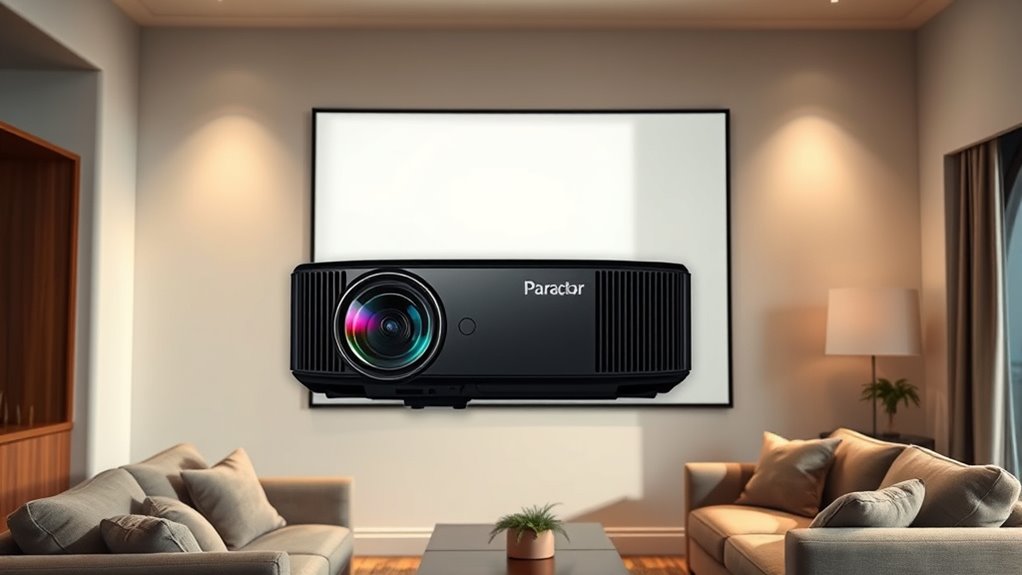
Short-throw and ultra-short-throw projectors offer innovative solutions for creating large images in small spaces, making them ideal for classrooms, offices,, and home theaters. These projectors are designed to be placed very close to the screen or wall, allowing you to project sizeable images without the need for extensive space. However, despite their advantages, they come with certain installation challenges you should be aware of. For example, because these projectors are positioned so close to the display surface, aligning them perfectly can be tricky. Small miscalculations in placement can lead to issues like keystone correction or image distortion, which can affect the overall quality of your projection. Guarantee the projector is level and at the correct height is essential to avoid skewed images or uneven borders.
Additionally, the proximity of these projectors to the screen means that even minor misalignments can result in distorted images, which can be distracting or reduce visibility. You might find yourself adjusting the projector multiple times to get a clear, undistorted picture—especially if the mounting isn’t secure or if the surface isn’t perfectly flat. This need for precise installation can sometimes require specialized mounting brackets or professional setup, adding to the initial cost and effort.
Another challenge is dealing with image distortion caused by lens characteristics or the projector’s placement. For example, ultra-short-throw projectors, due to their design, may produce slight barrel distortion or other optical issues if not properly calibrated. To combat this, many models include built-in correction features, but relying solely on these can sometimes compromise image sharpness or clarity. You’ll need to spend time fine-tuning the focus and correction settings to ensure a crisp picture.
Despite these installation challenges and potential for image distortion, short-throw and ultra-short-throw projectors are highly versatile and space-efficient. They eliminate the need for long projection distances, freeing up room and reducing shadows during presentations. To get the best results, plan your setup carefully—measure your space, choose the right mounting options, and spend time calibrating the image. While the installation process might demand extra effort upfront, the payoff is a large, vibrant display that enhances your viewing or presentation experience. Proper calibration can also help optimize color accuracy and contrast ratio, ensuring a high-quality visual output. Once properly installed, these projectors deliver impressive visuals without the clutter and constraints of traditional setups, making them a smart choice for many small-space environments.
Frequently Asked Questions
Can Short-Throw Projectors Be Used Outdoors?
Yes, you can use short-throw projectors outdoors, but you need to consider outdoor durability and installation. Make certain the projector is weatherproof or protected from elements like rain, wind, and dust. Proper installation is vital—mount it securely in a shaded area to avoid glare and overheating. Using a protective enclosure and placing it on a stable surface helps, making your outdoor setup more effective and long-lasting.
How Do Ultra-Short-Throw Projectors Handle Ambient Light?
You’ll find that ultra-short-throw projectors excel at ambient light management, with many designed to perform well even in brightly lit rooms. They handle ambient light by having high brightness levels and specialized optics that minimize washout. Their compact projector placement keeps the light source close to the screen, reducing ambient light interference. This makes them ideal for spaces where controlling lighting is challenging, ensuring clear, vibrant images regardless of surrounding brightness.
What Is the Lifespan of a Typical Short-Throw Projector Lamp?
A typical short-throw projector lamp lasts around 5,000 to 10,000 hours, depending on usage and model. You should consider lamp longevity when planning for replacements, as frequent use can shorten lifespan. Keep an eye on brightness and color quality, which may decline before the lamp burns out. Regular maintenance and timely replacements help guarantee your projector performs well and avoids unexpected outages.
Are Ultra-Short-Throw Projectors Suitable for 4K Content?
This is the best news you’ll hear – ultra-short-throw projectors are fully compatible with 4K content! You’ll enjoy stunning resolution clarity, making every movie or presentation feel like you’re right there. They’re perfect for small spaces, providing crisp images with minimal setup. Whether you’re watching movies or gaming, these projectors deliver high-quality visuals close to the screen, proving that size doesn’t compromise superb 4K performance.
What Are the Maintenance Requirements for Short-Throw Projectors?
You need to regularly perform maintenance on your short-throw projector to guarantee peak performance. Replace the lamp when it dims or reaches its recommended lifespan, usually every 2,000 to 4,000 hours. Keep it clean by dusting the vents and cleaning the lens with a soft, dry cloth. Check and replace filters if your model has them, and ensure ventilation areas stay unobstructed to prevent overheating.
Conclusion
Just like the great storytellers of old, your projector can bring worlds to life right before your eyes. Whether you choose a short-throw or ultra-short-throw model, you’re stepping into a domain where space and clarity unite, transforming your room into a personal cinema. Embrace this technology and create memories that shine brighter than any star. After all, isn’t it time your space echoed with the magic of movies, just as legends echo through history?
